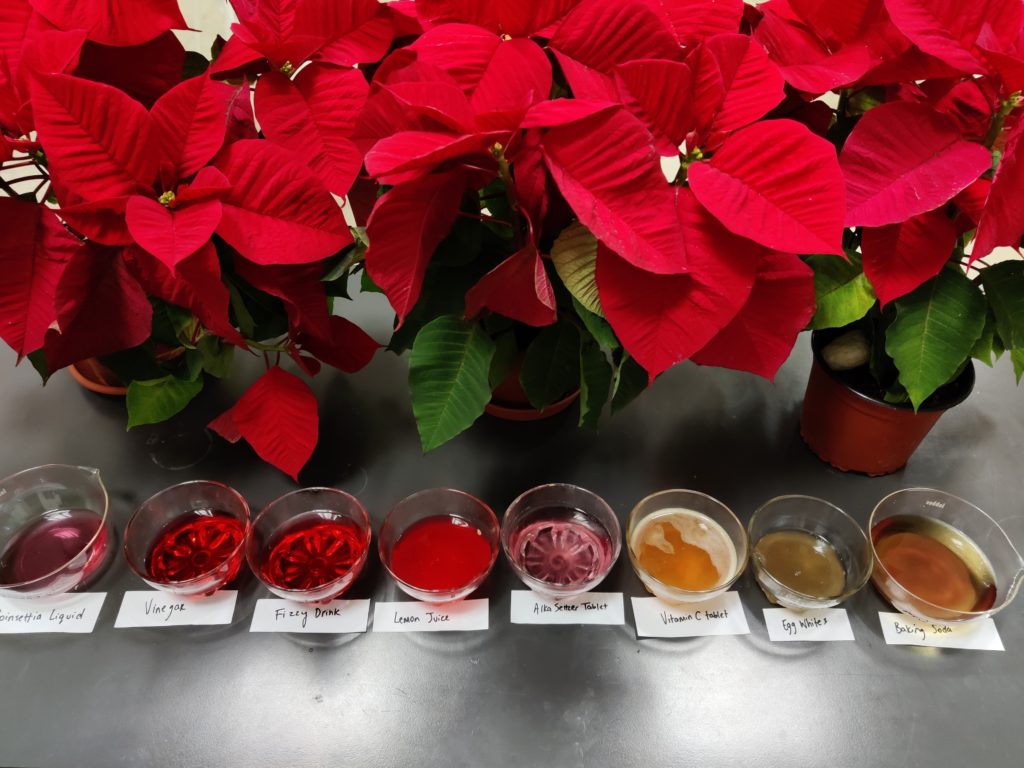Holiday Chemistry – Make a pH indicator from poinsettia leaves!
Today we’re going to be creating our very own pH indicator. But what is a pH indicator? And what is it used for?
In chemistry, if something is acidic, we say it has a low pH. And if something has a high pH, we say it’s a base. An example of an acid which we can find at home is lemon juice, and an example of a base is laundry detergent.
We use what we call pH indicators to see (to indicate) whether something is acidic or a base. There are a lot of indicators used by scientists, such as phenolphthalein and litmus. Different indicators are used for specific ‘ranges’. For example, phenolphthalein is a great indicator to use to check whether something is a base since it turns colourless in acidic solutions and pink in basic solutions. When different indicators are mixed together, you get what is called a universal indicator. It’s considered as universal because it has a wide range. It changes to different colours at different pH numbers, from red for strongly acidic solutions to a dark purple for strong basic solutions.
pH indicators are used for all sorts of things. It helps farmers and gardeners check the pH of their soil to find out which plants would grow best at that pH. Scientists use indicators to check the quality of water and doctors use indicators to check the amount of acid in our bodies since it affects our kidneys and causes other health problems.
Today we’re going to be using indicators to see whether items in our kitchen are acidic, neutral or basic. But, we’re giving indicators a Christmas twist by using our favourite plant for this time of the year – poinsettias!
Poinsettias are great plants to indicate the pH of a liquid because they contain anthocyanin pigments which are very sensitive to acidity changes. The anthocyanin is what gives poinsettia leaves their red colour, and which makes the poinsettia indicator solution red. But when the poinsettia liquid is added to an acid or a base, the anthocyanin will change colour. It will turn yellowish-green if the solution is a base, pink when neutral and bright red/pink if it is acidic.
Get your tools and materials ready!
Try it out!
Follow the instructions below or check out this video:
Safety Notes:
Step 1: Prepare the Poinsettia indicator
Step 2: Prepare the solutions to test!
Our homes are full of acids and bases. Strong acids and bases are usually used as cleaning products around the house. But these are toxic if ingested, can cause skin irritation, and shouldn’t be handled by kids. Instead, we decided to use some weak acids and basis which can be found in the kitchen.
What you can test:
Egg whites, vinegar, rice vinegar, baking soda, lemon juice, drinking water, water from the sink, antacid tablet, vitamin C tablets, hand soap mixed with water, dish soap mixed with water.
Solution is easier to test than solids. Dissolve powders such as baking soda in water to create a solution which you can test. If you have tablets such as antacid or vitamin C tablets, you can crush them in a pestle and mortar and mix them in with water as well. It’s best to dissolve them in drinking water since water directly from the sink tap tends to be basic and might affect the pH of the solution you’re trying to test.
Pour each solution/liquid in a separate container/glass.
Step 3: Download Activity Sheet
Download the activity sheet from here and list down the solutions you are testing, and the colour of the solution.
Step 4: Test their pH!
Strain the leaves to get the deep pink pH indicator. Pour a little bit of each liquids/solutions into different glasses or bowls. Then pour in some of the pH indicator into each container.
Observe the colour changes. Use the activity sheet to record the change in colour.
If your pH indicator does not change colour, that means the solution you’re testing is neutral. If it turns yellowish-green the solution is a base, and bright red/pink if it’s acidic.
 |
Store the poinsettia liquid in the fridge.
Share your experiment with us on social media by tagging us on social media @esploramalta #esploramalta #getcuriousgetinspired
Take it further!
You can also use red cabbage juice as a pH indicator. You can soak thick paper or kitchen roll paper in the liquid to make works of art!
Follow the instructions in this video to check out how: https://www.youtube.com/watch?v=WemYm1uZx6E
Can you find other plants, fruits and vegetables which can be used as a pH indicator? Hint: think of dark coloured fruits and veggies!
Show us what you’ve made! Take a photo of at least 4 of your favourite activities from Esplora’s Science Advent Calendar. Trust us, you’ll need them